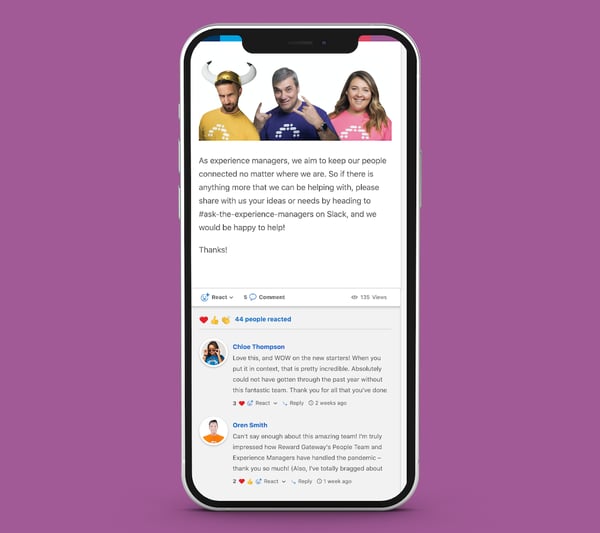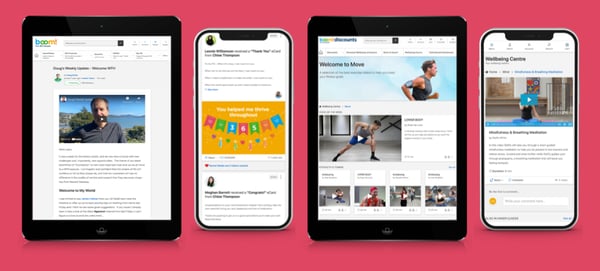Want to learn how managers can lead a hybrid workforce through change? If there’s anything we can say with certainty after the last few years, it’s that work as we know it has changed forever (and if it hasn’t changed all that much for you, it most certainly will!). If we want our teams to thrive in an evolving environment, that means our management approaches have to change with it.
 The most obvious change is the widespread movement towards more flexible, remote and hybrid work. Global studies show that 7 in 10 employees say their job satisfaction and work-life balance has improved since the shift to remote work, but that doesn’t mean it comes without challenges.
The most obvious change is the widespread movement towards more flexible, remote and hybrid work. Global studies show that 7 in 10 employees say their job satisfaction and work-life balance has improved since the shift to remote work, but that doesn’t mean it comes without challenges.
Working in physically distanced workspaces means that our team members are automatically less visible and ad-hoc collaboration and opportunities to connect socially occur less frequently.
If we don’t proactively change how to manage and support this hybrid workforce, our employees will be left feeling disconnected and disengaged.
Cultivate an ‘always-on’ feedback culture
Employees’ locations and the amount of face-time they have with other members of the organisation will impact their access to information and possible influence on business decisions that could impact their employee satisfaction. To counter a potential imbalance, it’s important to provide all employees the channels to provide feedback on a regular basis.
For years, changemakers have been saying that Annual Performance Reviews and Annual Engagement Surveys are too few and far between. A year of constant disruption shows that annual anything is definitely ‘too little’ (and action on the outdated feedback is definitely ‘too late’).
How do you create an always-on feedback culture where employees not only feel comfortable speaking up, but have the tools to do so?
- Schedule frequent (ideally, weekly) one-to-ones. Resist the urge to skip them! Get a recurring meeting in that calendar and commit to connecting – whether it’s over coffee, lunch, Zoom or a good old-fashioned phone call. Use that time to catch up on life outside of work as well as what’s on your business-related to-do list. Ask, “What are you proud of?” to push beyond the basics to the hidden successes. Connect on a human level.
- Spark conversation with social cues in technology. Enable the social features and functionality of blog platforms to encourage reactions, likes and comments. Encourage leaders to engage in these conversations to send the message that these forums are important. This gives you immediate employee feedback from readers and gives them the opportunity to keep the conversation going.
- Create the environment for instant feedback. Add polls and pulse surveys to your existing communication channels: Instead of releasing long-winded surveys that take 10 minutes to complete, send out 1 or 2 questions about something you/your team can act on.

Focus on value, not volume
Remember the time shortly after lockdown was announced and everyone booked back-to-back video meetings to over-compensate for not seeing each other face to face? Yeah… let’s not relive those days.
In addition to Zoom fatigue, email and instant-messaging fatigue is real: people are already so overwhelmed in their inboxes it is hard to get them to read emails in the first place. As a manager, you can empower people with relevant, valuable information and give them the freedom to engage with it as and when they need and want it:
- Get rid of the ‘All Staff email.’ It’s so 2010. This decade, embrace the power of a centralised, searchable news feed with the option to follow authors and segment messages so that the right people get the right message and the right time. BONUS: No Reply All!
- Embrace multi-format digital internal communications. Not everyone wants to read long blog posts - sometimes a 2-minute video summarising your key points that was filmed with your smartphone is all you need. Play around with the layouts of your blogs, too. Use images that break-up the text and draw attention to important sections so they don’t go unnoticed.
- Make it easy for people to access information. Technology can help provide employees with on-the-go access to the information and resources they need so they can catch up on the bus ride home or while they’re sitting on their couch. This applies to company communications, as well as recognition, reward and even employee wellbeing resources. Think about what work-life integration really looks like. It’s reading a CEO update and sending someone an eCard while waiting in line at the coffee shop, and using the same platform to do a 20-minute ClassPass exercise video during your lunch break, and a 5-minute meditation session at the end of your work day.
It’s all about meeting your people where they are, and technology can help you do just that.

As we shift the gears and create a ‘new business as usual,’ leaders are going to need a new approach to successfully motivate and inspire a new type of workforce.
 Joy Adan
Joy Adan

